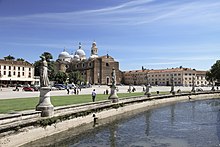Prato della Valle
45°23′54″N 11°52′33″E / 45.39833°N 11.87583°E



Prato della Valle (Prà de ła Vałe in Venetian) is a 90,000-square-meter elliptical square in Padua, Italy. It is the second largest square in Italy and one of the largest in Europe. Today, the square is a large space with a green island at the center, l'Isola Memmia, surrounded by a small canal bordered by two rings of statues.
History

Prior to 1635, the area that would come to be known as the "Prato della valle" was largely a featureless expanse of partially swampy terrain just south of the old city walls of Padova. In 1636, a group of Venetian and Veneto notables financed the construction of a temporary but lavishly appointed theater as a venue for mock battles on horseback. The musical entertainment that served as the prologue to the jousting is considered to be the immediate predecessor of the first public opera performances in Venice, which began the following year.
In 1767, the square, which belonged to the monks of Santa Giustina, became the public property of the city of Padua. In 1775, Andrea Memmo, whose statue is in the square, decided to reclaim and restructure the entire area. The entire project, which was never fully completed, is represented in a famous copper engraving by Francesco Piranesi from 1785. It seems that Memmo commissioned this and other representations and kept them on exhibition at the Palazzo Venezia, the headquarters of the Embassy of the Republic in Rome. He did this in order to entice other important figures into financing the construction of statues to decorate the square. The project was approved by Domenico Cerato, professor of architecture at Vicenza and Padova.
The preliminary excavations done to install the plumbing system and reclaim the area were directed by Simone Stratico. These excavations brought to light the remains of an ancient Roman theater. These findings conferred a sense of historical dignity on the initiative and transformed it into a project of reclamation for its natural public use. Andrea Memmo resided at
Of particular interest are the Benedictine Abbey of Santa Giustina, the neoclassical style Loggia Amulea, and the many interesting palazzi constructed between the 14th and the 18th centuries that surround the square.

Prato della Valle today
Prato della Valle has long been dear to the hearts of Paduans, who often simply refer to it as Il Prato. At various times, it was also known as the valley without grass, because the shade of trees prevented much grass from growing there. Today, however, it is completely covered with grass and other vegetation.
During the 1990s, the Prato went through a period of degradation and neglect, but today it has been restored through reclamation projects organized by a group of Padua's concerned citizens. During the summer, the square is alive with large numbers of visitors who skate, stroll, or study while basking in the sun. Summer evenings are marked by the presence of teenagers and young adults who chat until the early hours of the morning.
For several years running, the Prato della Valle has hosted the Paduan section of the Festivalbar, and has also played host to skating competitions that have availed themselves of the wide, paved ring that surrounds the square.
Every New Year's Day, and during the Feast of the Annunciation in mid August, parties with music and fireworks take place in the Prato.
The monumental 15th century building of the Palazzo Angeli, belonging to the City of Padova and once the home of Andrea Memmo, hosts the Museum of Precinema – Minici Zotti Collection.
Statues
Today there are 78 statues (40 in the exterior ring and 38 statues in the inner ring); following the original plan, there had been 88 statues. They were made from stone of Vicenza between 1775 and 1883 by various artists. One of the statues represents Andrea Memmo, the patrician Venetian known as the provider of Padova.
The numeration follows the sculpted numbers on the base of the statues.

|
Exterior ring
|
Inner ring
|
Statues of Venetian Doges, destroyed by Napoleon in 1797:
|
See also
References
Bibliography
- Pierluigi Petrobelli." L'Ermiona di Pio Enea Obizzi ed i primi spettacoli d'opera venetiani" in La nuova musicologica italiana, Torino, Einaudi, 1965 (Quaderni della rassegna musicale, 3)
- Prosdocimi, Aldo. Il Prato della Valle, Padova. 1978.
- Stratico, Simone. Dell'antico teatro di Padova, Padova, 1795.
- Stefano Zaggia. Isoletta sacra al commercio ed all’arti". Andrea Memmo, Melchiorre Cesarotti e il Prato della Valle come esperimento di riforma del paesaggio urbano, in Melchiorre Cesarotti e le trasformazioni del paesaggio europeo, a cura di F. Finotti, Trieste, EUT, 2010, pp. 112–128. http://hdl.handle.net/10077/4458
Notes
- ^ At the bottom of Piranesi's engraving, one can read the following descriptive text: Prospectus of the new square following the general idea already conceived and in large part implemented by his Excellency Mr. Andrea Memmo Cavaliere and Procurator of S. Marco when he was extraordinary provider of the Serene Republic of Venice, between the years MDCCLXXV and VI. Above marshy terrain containing the space of 974,012 square geometric feet and called therefore the square of the valley, the island destined for public walks, art museums and statues which adorn it proudly with figures of merchants and animals, indication of spectacular woods, lakes, streets, bridges and many other ornaments which can be discovered without explanation.
- ^ The present statue, number 81, was made after 1797 and Morosini is represented as an ancient Roman hero instead of the Doge of Venice
